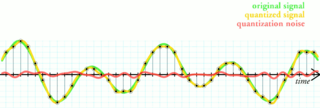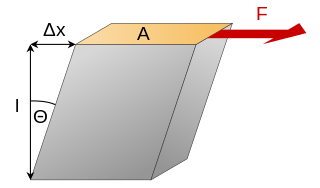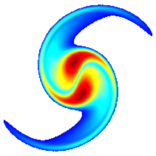Related Research Articles

The International Obfuscated C Code Contest is a computer programming contest for the most creatively obfuscated C code. Held annually in the years 1984–1996, 1998, 2000, 2001, 2004–2006, 2011–2015 and then in 2018, it is described as "celebrating [C's] syntactical opaqueness". The winning code for the 25th contest, held in 2018, was released in May 2018.
In fluid mechanics, a fluid is said to be in hydrostatic equilibrium or hydrostatic balance when it is at rest, or when the flow velocity for each parcel of fluid is constant over time. This occurs when external forces such as gravity are balanced by a pressure-gradient force. For instance, the pressure-gradient force prevents gravity from collapsing Earth's atmosphere into a thin, dense shell, whereas gravity prevents the pressure gradient force from diffusing the atmosphere into space.

Rhea is the second-largest moon of Saturn and the ninth-largest moon in the Solar System. It is the second smallest body in the Solar System for which precise measurements have confirmed a shape consistent with hydrostatic equilibrium, after dwarf planet Ceres. It was discovered in 1672 by Giovanni Domenico Cassini.
A discrete element method (DEM), also called a distinct element method, is any of a family of numerical methods for computing the motion and effect of a large number of small particles. Though DEM is very closely related to molecular dynamics, the method is generally distinguished by its inclusion of rotational degrees-of-freedom as well as stateful contact and often complicated geometries. With advances in computing power and numerical algorithms for nearest neighbor sorting, it has become possible to numerically simulate millions of particles on a single processor. Today DEM is becoming widely accepted as an effective method of addressing engineering problems in granular and discontinuous materials, especially in granular flows, powder mechanics, and rock mechanics. DEM has been extended into the Extended Discrete Element Method taking heat transfer, chemical reaction and coupling to CFD and FEM into account.

Computational fluid dynamics (CFD) is a branch of fluid mechanics that uses numerical analysis and data structures to analyze and solve problems that involve fluid flows. Computers are used to perform the calculations required to simulate the free-stream flow of the fluid, and the interaction of the fluid with surfaces defined by boundary conditions. With high-speed supercomputers, better solutions can be achieved, and are often required to solve the largest and most complex problems. Ongoing research yields software that improves the accuracy and speed of complex simulation scenarios such as transonic or turbulent flows. Initial validation of such software is typically performed using experimental apparatus such as wind tunnels. In addition, previously performed analytical or empirical analysis of a particular problem can be used for comparison. A final validation is often performed using full-scale testing, such as flight tests.

Quantization, in mathematics and digital signal processing, is the process of mapping input values from a large set to output values in a (countable) smaller set, often with a finite number of elements. Rounding and truncation are typical examples of quantization processes. Quantization is involved to some degree in nearly all digital signal processing, as the process of representing a signal in digital form ordinarily involves rounding. Quantization also forms the core of essentially all lossy compression algorithms.
In continuum mechanics, the Froude number is a dimensionless number defined as the ratio of the flow inertia to the external field. Named after William Froude (;), the Froude number is based on the speed–length ratio which he defined as:

In materials science, shear modulus or modulus of rigidity, denoted by G, or sometimes S or μ, is defined as the ratio of shear stress to the shear strain:
Used in hydrogeology, the groundwater flow equation is the mathematical relationship which is used to describe the flow of groundwater through an aquifer. The transient flow of groundwater is described by a form of the diffusion equation, similar to that used in heat transfer to describe the flow of heat in a solid. The steady-state flow of groundwater is described by a form of the Laplace equation, which is a form of potential flow and has analogs in numerous fields.

In geometric optics, distortion is a deviation from rectilinear projection; a projection in which straight lines in a scene remain straight in an image. It is a form of optical aberration.
Fluid mechanics is the branch of physics concerned with the mechanics of fluids and the forces on them. It has applications in a wide range of disciplines, including mechanical, civil, chemical and biomedical engineering, geophysics, oceanography, meteorology, astrophysics, and biology.
Direct Simulation Monte Carlo (DSMC) method uses probabilistic simulation to solve the Boltzmann equation for finite Knudsen number fluid flows.

MODFLOW is the U.S. Geological Survey modular finite-difference flow model, which is a computer code that solves the groundwater flow equation. The program is used by hydrogeologists to simulate the flow of groundwater through aquifers. The source code is free public domain software, written primarily in Fortran, and can compile and run on Microsoft Windows or Unix-like operating systems.

The shallow water equations are a set of hyperbolic partial differential equations that describe the flow below a pressure surface in a fluid. The shallow water equations in unidirectional form are also called Saint-Venant equations, after Adhémar Jean Claude Barré de Saint-Venant.

TITAN2D is a geoflow simulation software application, intended for geological researchers. It is distributed as free software.
The material point method (MPM) is a numerical technique used to simulate the behavior of solids, liquids, gases, and any other continuum material. Especially, it is a robust spatial discretization method for simulating multi-phase (solid-fluid-gas) interactions. In the MPM, a continuum body is described by a number of small Lagrangian elements referred to as 'material points'. These material points are surrounded by a background mesh/grid that is used only to calculate gradient terms such as the deformation gradient. Unlike other mesh-based methods like the finite element method, finite volume method or finite difference method, the MPM is not a mesh based method and is instead categorized as a meshless/meshfree or continuum-based particle method, examples of which are smoothed particle hydrodynamics and peridynamics. Despite the presence of a background mesh, the MPM does not encounter the drawbacks of mesh-based methods which makes it a promising and powerful tool in computational mechanics.
In computational fluid dynamics, TELEMAC is short for the open TELEMAC-MASCARET system, or a suite of finite element computer program owned by the Laboratoire National d'Hydraulique et Environnement (LNHE), part of the R&D group of Électricité de France. After many years of commercial distribution, a Consortium was officially created in January 2010 to organize the open source distribution of the open TELEMAC-MASCARET system now available under GPLv3.
The Geochemist's Workbench (GWB) is an integrated set of interactive software tools for solving a range of problems in aqueous chemistry. The graphical user interface simplifies the use of the geochemical code.

RELAP5-3D is a simulation tool that allows users to model the coupled behavior of the reactor coolant system and the core for various operational transients and postulated accidents that might occur in a nuclear reactor. RELAP5-3D can be used for reactor safety analysis, reactor design, simulator training of operators, and as an educational tool by universities. RELAP5-3D was developed at Idaho National Laboratory to address the pressing need for reactor safety analysis and continues to be developed through the United States Department of Energy and the International RELAP5 Users Group (IRUG) with over $3 million invested annually. The code is distributed through INL's Technology Deployment Office and is licensed to numerous universities, governments, and corporations worldwide.

Gerris is computer software in the field of computational fluid dynamics (CFD). Gerris was released as free and open-source software, subject to the requirements of the GNU General Public License (GPL), version 2 or any later.
References
- ↑ A.K. Patra, A.C. Bauer, C.C. Nichita, E.B. Pitman, M.F. Sheridan, M. Bursik, B. Rupp, A. Webber, A. Stinton, L. Namikawa, and C. Renschler, Journal of Volcanology and Geophysical Research, 139 (2005) 1-21.
- ↑ titan2d_ userguide.pdf, Release 2.0.0, 2007.07.09
- ↑ L. Yuan, W. Liu, J. Zhai, S.F. Wu, A.K. Patra, E.B. Pitman, Refinement on non-hydrostatic shallow granular flow model in a global Cartesian coordinate system, arXiv : 1602.03299, 2016